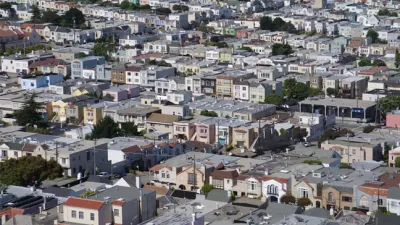Senate Bill 50, by Scott Wiener, advanced on two fronts last week: On Wednesday, it passed easily out of its first committee with new "Minneapolis-style" amendments. On Sunday, it received a New York Times editorial endorsement.

What a difference a year makes. At this time last year, the state's most controversial housing bill, Senate Bill 827, also by Sen. Scott Wiener, Democrat of San Francisco, died on a 4-6-3 vote in the Senate Transportation and Housing Committee. By contrast, Senate Bill 50, dubbed the More HOMES Act by the author and new chair of the Senate Housing Committee, passed out of the Senate Governance and Finance committee on a 6-1-0 vote on April 24.
Key to its passage was an agreement "to go easier on smaller-sized counties" by incorporating provisions of a rival bill authored by the chair of the committee, Sen. Mike McGuire, Democrat from Healdsburg, as explained by Matt Levin, data and housing reporter for CALmatters, a nonpartisan, nonprofit journalism on California government.
Most cities in those smaller counties [less than 600,000 residents] would be forced to allow housing near public transit that’s slightly more dense than what’s currently allowed, but not 4-5 stories. They also would also be required to approve duplexes, triplexes and four-plexes “by right” in almost all neighborhoods, allowing developers to bypass the often lengthy and costly process of getting small housing projects approved by local planning commissions and city councils.
Advocates for Wiener’s bill point out that even the weaker density requirements on smaller counties could lead to a substantial boost to new housing—and that the “four-plex” provision in particular means an end to neighborhoods zoned exclusively for single-family homes. The city of Minneapolis made national headlines for a similar law last year [see Planetizen tag, Minneapolis 2040 Comprehensive Plan.]
While the bill still faces fierce political opposition and a long road ahead in the state Legislature, the vote marks a significant victory for Wiener’s move to promote more dense housing around transit—an approach he says is necessary to help alleviate the state’s housing shortage and curb greenhouse gas emissions from commuters.
That last note provides a nice segue to The New York Times Sunday Review, "California Has a Housing Crisis. The Answer Is More Housing," by their editorial board. The editorial is especially noteworthy it two areas - its assertions on gentrification and climate.
Opponents of the legislation ... seem confused about the mechanics of the marketplace. The spread of gentrification in California is driven by the lack of housing. The state’s population continues to grow [though well below the national average rate]; the question confronting policymakers is where to put those people. Under the current rules, the state’s effective plan is to cede urban areas to the wealthy while forcing less affluent families to live on the state’s ever-more-distant suburban fringes.
Even if the state can reduce rents and home prices by greatly increasing the amount of new housing, California still needs to find the means and will to subsidize housing for those who cannot afford market-rate units. But it would be a mistake to preserve some affordable housing by preventing the construction of more affordable housing.
As for the climate connection, it was just over a month ago that the Times published an opinion by Wiener and UC Berkeley energy professor Daniel Kammen that made similar points their editors make below.
The bill also is a necessary piece of the response to another crisis: climate change. Cities like San Francisco and Los Angeles — landscapes of tall buildings, concrete and traffic-clogged streets — are the most environmentally friendly places for human life on earth. The Harvard economist Edward Glaeser has calculated that the residents of California’s core cities use about one-fourth less carbon per year than the residents of the surrounding suburbs. Better yet, the residents of California’s cities use less carbon than the residents of any other large American cities because the temperate climate limits the use of air-conditioning and heating.
The paradox, as Mr. Glaeser notes, is that the California coast — the most environmentally friendly place in America for dense housing — is one of the hardest places to build such housing.
It is time to rewrite the rules: The solution to California’s housing crisis is more housing.
Related in Planetizen:
-
Housing Crisis Derailing California's Climate Strategy, March 31, 2019 [NYT opinion by Wiener and UC Berkeley energy professor Daniel Kammen on SB 50.]
-
Putting a Bow on Top of the Minneapolis 2040 Comprehensive Plan, December 10, 2018
Hat tip to POLITICO California Playbook.
FULL STORY: California’s hottest housing bill moves ahead—with a break for smaller counties

Montreal Mall to Become 6,000 Housing Units
Place Versailles will be transformed into a mixed-use complex over the next 25 years.

Planetizen Federal Action Tracker
A weekly monitor of how Trump’s orders and actions are impacting planners and planning in America.

Four Reasons Urban Planners Can’t Ignore AI
It’s no longer a question of whether AI will shape planning, but how. That how is up to us.

Bend, Deschutes County Move to Restrict Major Homeless Encampment
City and county officials are closing off portions of an area known as Juniper Ridge where many unhoused residents find shelter, hoping to direct people to housing and supportive services.

High Housing Costs Driving Down Transit Ridership in LA
When neighborhoods gentrify and displace lower-income residents, transit ridership suffers, new research shows.

Iowa Legalizes Accessory Dwelling Units
A new law will allow property owners to build ADUs on single-family lots starting on July 1.
Urban Design for Planners 1: Software Tools
This six-course series explores essential urban design concepts using open source software and equips planners with the tools they need to participate fully in the urban design process.
Planning for Universal Design
Learn the tools for implementing Universal Design in planning regulations.
City of Mt Shasta
City of Camden Redevelopment Agency
City of Astoria
Transportation Research & Education Center (TREC) at Portland State University
City of Camden Redevelopment Agency
Municipality of Princeton (NJ)
Regional Transportation Commission of Southern Nevada





























